Menu

Did you know that using renewable energy equipment can lower U.S. greenhouse gas emissions by 10%? Farmers around the world are turning to the sun, wind, and biofuels. This change helps both the planet and the pocket. Green farming tools are slowly becoming the norm.
Renewable energy has become key for farms. It helps tackle the challenges of changing energy prices. More and more farms are using renewable energy to ensure they are stable in the long run and lower costs.
Now, there are many sustainable farming technologies. These include using the sun, wind, and biofuels. For example, solar power is popular for cutting electricity costs on farms. Wind energy is great in windy areas, offering clean power.
Biofuels are made from crops like corn and offer a clean fuel choice. By using these and other renewable options, farms can lower their costs and be more efficient.
Big farms can really benefit from large renewable setups. They can power their work and even sell spare power. This brings in more money for them.
There are also financial perks for going green. The government offers help through programs and tax breaks. These can make adding solar or wind power much more affordable.
Using biomass for energy more could mean a lot for farmers. It could bring in up to $20 billion and help fight climate change. It’s like taking 70 million cars off the road.
Let’s compare some top renewable energy options for farming:
| Renewable Energy Source | Benefits | Drawbacks |
|---|---|---|
| Solar Power | Reduces electricity bills, potential for additional income from selling excess power | High initial installation cost, weather-dependent efficiency |
| Wind Energy | Clean electricity production, usable land around turbines | High upfront cost, location-specific efficiency |
| Biofuels | Environmentally friendly, utilises crop by-products | Poor cold-weather performance, sediment formation |
Renewable farming solutions offer more than just energy. They bring independence, help the environment, and strengthen the economy. Taking up these solutions leads to a better and more secure future for farming.
Renewable energy farming equipment is key in today’s agriculture. Switching to environmentally friendly agricultural gear helps farms be more independent and earth-friendly. By using solar power, farmers can lower their power bills and use less of finite resources.
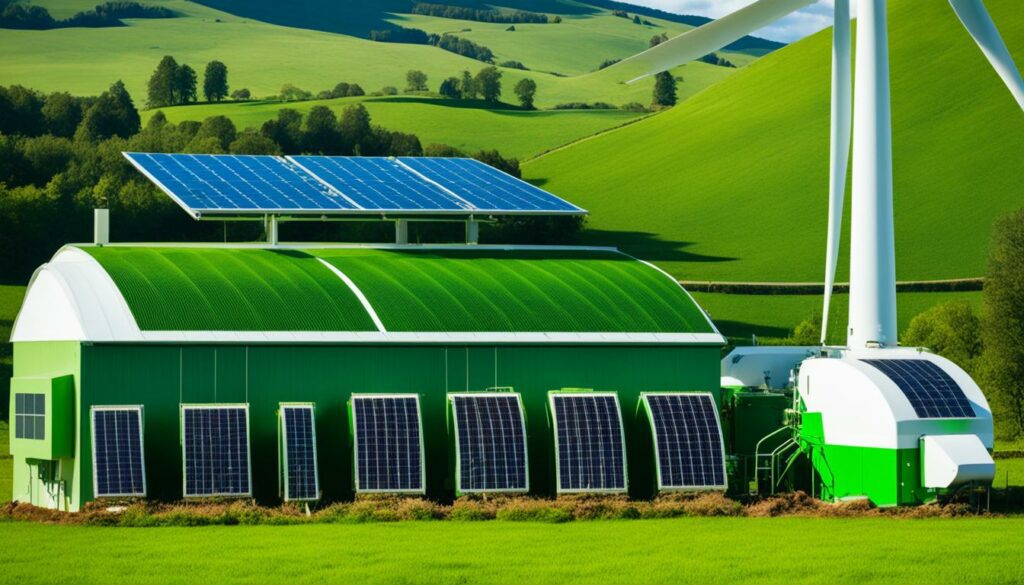
Wind energy is also key for many farms, especially those in windy areas. It lets farmers create their own power. They can even sell any extra power, bringing in money. For big farms, using wind or solar power over a wide area can mean lots of clean energy.
Using renewable energy also makes good financial sense. There are schemes like REAP and ITC that give big discounts or tax breaks for going green. This helps cover up to half of the costs. With a smart blend of grants and loans, up to 75% of the bill can be covered.
The USDA’s Bioenergy Program helps farmers make clean fuels like biodiesel and ethanol. These are also environmentally friendly agricultural gear. Making these fuels not only means farming is greener but also helps to cut down on harmful gases.
These changes help to keep fuel costs steady. This lets farmers plan their spending better. And, state schemes such as Agriculture Energy Efficiency Rebate support energy-saving projects. They make it easier for farms to use more environmentally friendly agricultural gear.
Solar energy is a key option for farms. It cuts electricity bills and lets farms make money by selling power. This way, solar power is an economic win for farmers.
Farmers get a 30% tax credit for installing solar panels. And there are more credits for businesses. Using farmland for solar power could be a big win; yet, only a small share is planned for solar energy use.
In the U.S., agricultural land can provide 27 TW of solar energy. This is a big part of the country’s solar energy capacity. Solar setups can work around farm needs, like allowing space for tractors to get through.
Solar energy changes how farms work. It powers things like irrigation and processing. Solar panels help farms produce more, even in colder places, by extending the growing season.
More solar power is key to cutting carbon from electricity. The U.S. has to ramp up its solar power each year to 2035. This push for solar shows its power for both the environment and the farm’s bottom line.
| Benefit | Description |
|---|---|
| Cost Reduction | Significant cut in electricity bills |
| Income Generation | Selling surplus electricity back to the grid |
| Tax Incentives | 30% investment tax credit for installations |
| Land Utilisation | Only 0.3% of farmland expected to be used for solar energy by 2035 |
| Versatility | Applications in powering irrigation, heating water, and more |
For solar help, farmers can check out the Farmer’s Guide to Going Solar. It gives lots of tips for setting up solar on the farm.
Wind energy is key for using renewable power on farms, especially in windy areas. It promotes green farming practices and boosts the economy. This innovation is both good for the environment and for the purse.
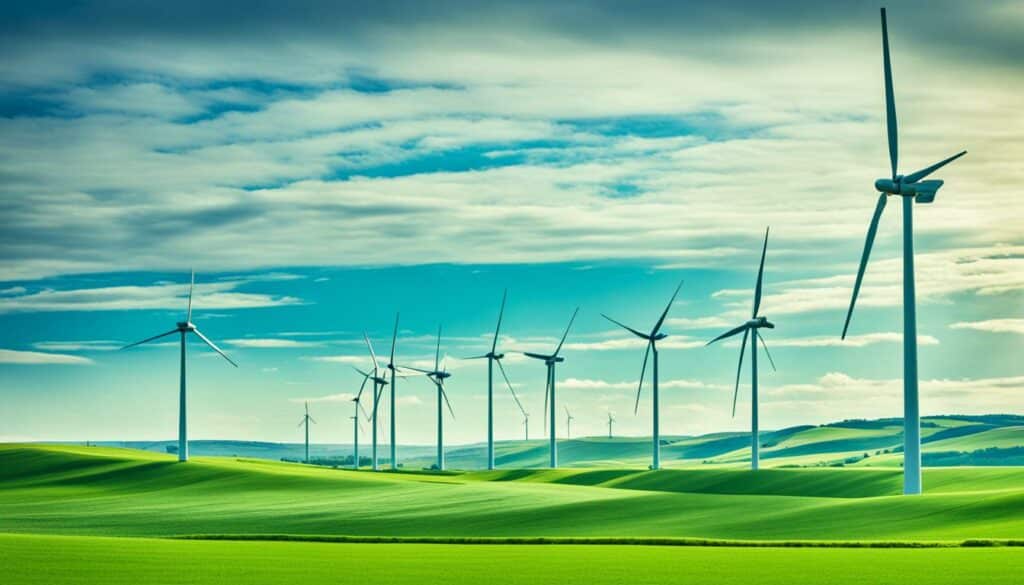
Farms in windy places benefit most from wind turbines. They change the wind’s power into electricity all day. This cuts down on outside energy needs.
Extra power can either be kept or sold. This allows farmers to make extra money. With an agreement for a fixed price over 20 years, it’s also good for planning ahead. Wind energy could save a huge $280 billion by 2050, according to the U.S. Department of Energy.
Wind turbines are carefully placed to make the best use of farm land. They fit in well with farm activity and enhance the land’s use. This means crops can still be grown, and animals can graze without any problems.
Wind farms also create many jobs. By 2050, over 135,000 people could be working with wind energy equipment. This trend not only supports green farming but also boosts job growth.
Wind turbines have even more to offer. The DOE thinks offshore wind turbines could double the U.S.’s electricity. This shows wind energy is a powerful, future-ready choice for farms.
Biofuel is becoming a popular choice as we look for eco-friendly fuel options. It’s made from plants like corn, soybeans, and oilseeds. This makes it renewable and lessens our need for oil and other non-renewable sources. For example, biodiesel not only helps the environment by reducing harmful emissions but also supports farming financially.
Farmers are using special technology to turn plants into biofuels like biodiesel and ethanol. This process is beneficial in two ways: it produces oil that can be used or sold, and it leaves high-quality meal to feed animals.
The government is supporting this change with programs like the Bioenergy Program and the REAP. These initiatives help farmers afford the technology needed to make biofuels. For example, the REAP can pay for half of a renewable energy project. It may give up to 75% of costs if you combine different funding options. Plus, another program called ITC can lower taxes by 30% for using solar power. These are big deals that make it easier for farmers to join the biofuel movement.
Let’s talk about a farmer in Vermont, Roger Rainville. He made biodiesel for less than $2 a gallon. This shows how biofuels can save money and increase profits. Thanks to support from the government and other programs, more farmers can get help with buying energy-saving equipment.
Farms that use biofuels also are using the latest in green technology. They’re starting to use solar and wind power. This helps save money and the environment.
The move to biofuels is smart business. It protects against high fossil fuel prices. This choice makes farming more sustainable in the long run. Using renewable energy helps build a stronger and greener farming system for the future.
| Programme | Benefit | Coverage |
|---|---|---|
| Investment Tax Credit (ITC) | Reduces federal income tax liability | Up to 30% of the costs |
| Rural Energy for America Program (REAP) | Increased funding and grant eligibility | 50% – 75% of the costs |
| Bioenergy Program for Advanced Biofuels | Encourages biofuel production | Various incentive schemes |
| Agriculture Energy Efficiency Rebate | Offers rebates for energy-efficient projects | Varies by project |
| Small Business Advantage Grant (SBAG) | Reimbursements for energy efficiency | Partial costs |
| Environmental Quality Incentives Program (EQIP) | Supports energy-efficient equipment | Post-energy audit participation |
Using renewable energy farming equipment is a big step towards sustainable farming. Farms are now adopting solar-powered tractors and wind turbine water pumps. This move is changing how farming works.
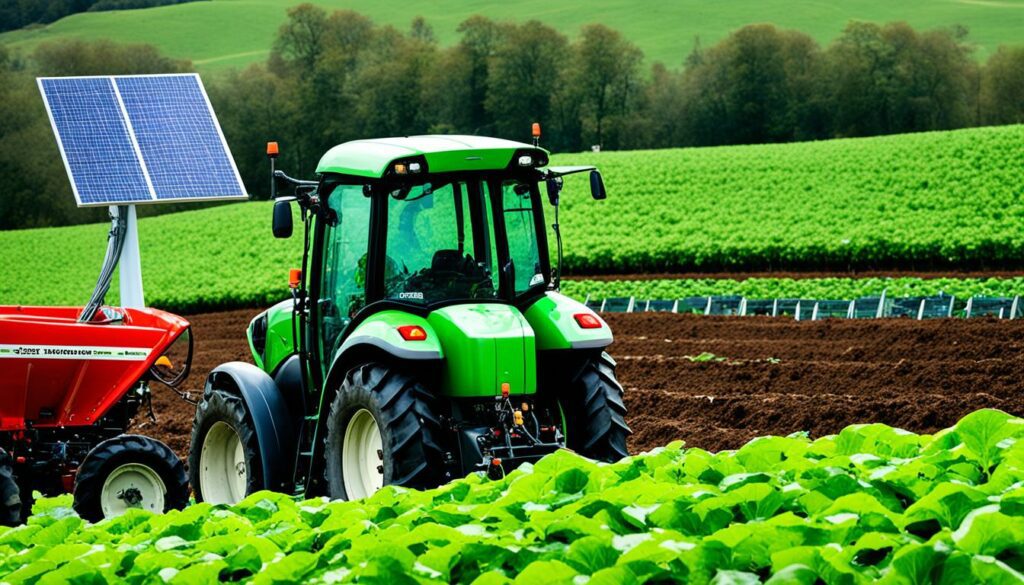
By using eco-friendly farming machinery, pollution is lower. It also saves money for farmers. Solar power and wind energy are reducing electricity costs. Places with a lot of wind can use it to power their farms easily.
Getting stuff like solar panels and wind turbines means we don’t need to rely on expensive energy. Big farms can make a lot of their own clean energy. This helps the environment and saves them money.
There are government programs to help farmers get into renewable energy. The Rural Energy for America Program (REAP) gives big grants. It can cover most of the cost of green projects. The Investment Tax Credit (ITC) also makes solar power more affordable by cutting taxes.
Using green energy farming devices is smart for the future. It makes farming more efficient, cost-effective, and earth-friendly. It’s important as we aim to make farming greener and more sustainable.
Integrating renewable energy into farming can lead to big economic gains. Let’s look at how it helps cut costs and adds to the income.
Using green energy in farming can slash bills. Solar power is a steady solution that trims electricity costs. Wind energy works well in windy areas. It lets farms either store or sell extra power. This helps make farms more budget-friendly and sustainable.
The USDA’s EQIP backs farmers in getting energy-saving gear. For solar systems, the ITC cuts taxes by 30%, saving a lot of money.
Renewable energy helps farmers earn more in different ways. They can sell extra power to the grid. Also, making biofuels from crops not only meets energy needs but also adds to profits.
Government schemes like REAP provide funds for green projects, up to 75%. Plus, state schemes like the SBAG encourage using more renewable energy.
| Energy Source | Benefits |
|---|---|
| Solar Power | Reduces electricity bills significantly; long-term cost-saving solutions |
| Wind Energy | Ideal in windy regions; excess electricity can be sold or stored |
| Biofuels | Environmentally friendly and stabilises fuel costs |
Renewable energy helps farms save money and make extra cash. It’s key to a healthy, profitable farm that takes care of the environment.
The move to using renewable energy in farming gets a lot of help from funding and incentives. The Rural Energy for America Program (REAP) gives big chances for grants, often covering half of the project’s cost. With REAP, a grant can be used with a loan to cover as much as 75% of your expenses. The Investment Tax Credit (ITC) can lower your tax bill by 30%, which helps a lot with solar system costs.
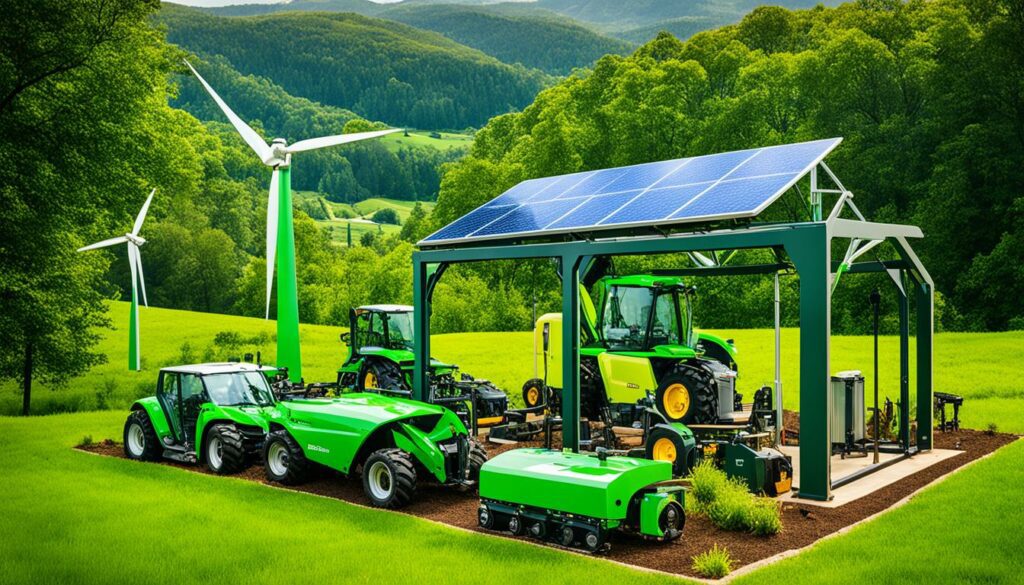
There are also state-level efforts to help out. For instance, the Department of Environmental Protection (DEP) offers the Agriculture Energy Efficiency Rebate Program and the Small Business Advantage Grant (SBAG). These give money back to those who choose energy-saving projects, reducing both project costs and pollution. The Agriculture Energy Efficiency Rebate Program is especially good for making green farming tools more available.
The USDA also plays a part in supporting renewable energy. Through programs like the Bioenergy Program for Advanced Biofuels, it pushes for making sustainable biofuels. The USDA’s EQIP On-Farm Energy Initiative gives funding after a farm passes an energy check. This shows the USDA’s focus on helping farms use sustainable tools and gear.
Farmers should talk to both federal and state groups for advice on their projects and tax benefits. For example, the PTC and ITC can help a lot if you’re using green energy. Knowing about these incentives can make starting up less costly.
The Renewable Electricity Production Tax Credit allows wind energy facility owners to claim a federal income tax credit for every kilowatt-hour of electricity generated, providing financial stability and encouraging clean energy advancements.
Also, many federal bodies fund work into new renewable energy sources, pushing for new ideas. The way the U.S. gets its electricity means nearly everyone benefits from cleaner energy. This push for sustainable farming tools and eco-friendly gear leads the change to a greener, more stable farming future.
It’s crucial for farms to learn how renewable energy can help them. Case studies show how clean energy tools improve farming. They tell us how these tools changed farm work.
Solar power is a big help on farms. An example is Tri-County Electric Cooperative in Minnesota. They made a solar array that can make 107,651 kWh a year. Farmers in the project buy shares for $1,400 and get energy bill savings for 20 years. Plus, the solar arrays come with long warranties and need little upkeep.
If your farm’s in a windy area, wind power is great. You can use the power yourself or sell it. This adds to your farm’s income. Wind turbines are put on the edges of fields. This way, farming activities like growing crops and raising animals can go on as usual.
“The successful deployment of wind turbines on farms showcases how renewable energy farming solutions can be seamlessly integrated without disrupting existing agricultural practices,” reported a recent case study.
Comparison tables can show the benefits of green energy. They help see what different cases have achieved:
| Energy Source | Project Details | Benefits |
|---|---|---|
| Solar Energy | Community solar array, 73.8 kW, 107,651 kWh annually | Reduced electricity costs, 1-to-1 kWh credit, long-term savings |
| Wind Energy | Integration of wind turbines in farm fields | Additional income, continuous agricultural use of land |
These tables show how green energy works on farms. They’re a good reason for others to try it. Green farming is good for the environment. It also makes farms more sustainable for the future.
Sustainable farming technology is picking up, but it faces hurdles. One hurdle is the need for a lot of money at the start. For example, solar panels and wind turbines cost a lot. They rely on the sun and wind, so we need good ways to store their energy.
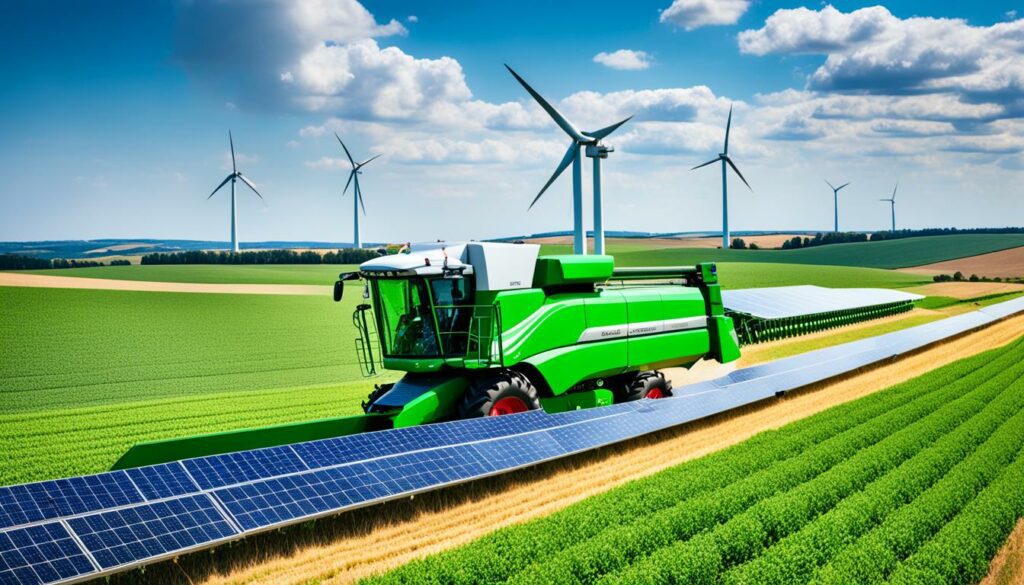
Wind power also has its issues. It needs a big area for wind farms. Then, there are places where we can’t use water or heat from the earth for power. These methods work only in certain areas. Making energy from plants can also be hard because of the land it needs and the pollution it can cause.
Thankfully, there are ways to make these technologies easier to use. Government money and working together with companies can help. Also, there are special programs that give money back for starting these projects.
Using smart technologies can make renewable energy work better. For example, computers can help us use the energy smarter. They can also predict when things might need fixing. Blockchains make the buying and selling of green energy easier to check.
Using smart grids can also make everything work together better. Denmark and Germany are good at this. They show how to mix renewable energy with regular power well.
By solving these issues smartly, we can make green farming machines and technology work better. This would make farming more sustainable and flexible.
The future of renewable energy farming equipment looks bright. New tech is key for farming that’s good for the planet. This includes better solar panels, hydrogen cells, and improved biofuels. These innovations will make farming more efficient and widespread.
Solar power is making a big impact on farms. It cuts electricity costs and is clean. Wind power is also growing, especially where there’s a lot of wind. This lets farmers sell extra power and make more money.
Biofuels are another green option. Farmers are making biodiesel and ethanol from crops. This reduces the use of fossil fuels and helps the environment. It also makes farms more financially stable. The USDA supports and promotes making these biofuels.
There are programs to help farmers use green energy. The REAP program gives grants for half the cost of projects. The ITC lowers taxes by 30% for solar. This makes buying and using green energy tech easier and cheaper.
Table of Key Statistics:
| Program | Benefit |
|---|---|
| REAP | Grants up to 50% of project costs |
| ITC | Reduces tax liability by up to 30% for solar |
| State Rebates | Incentives for energy-efficient projects |
| SBAG | Reimburses small businesses for energy improvements |
| EQIP On-Farm Energy Initiative | Assistance for energy efficiency projects |
All these steps lead to a crucial future. Green farming devices and clean energy are vital for farming to keep growing. Using these tools and ideas, we can move towards a greener and more sustainable farming future. This is good for our planet.
Renewable energy farming gear has great benefits for our planet. It cuts down on harmful greenhouse gases. This happens when farms switch their old machines for solar panels, wind turbines, and biofuels.
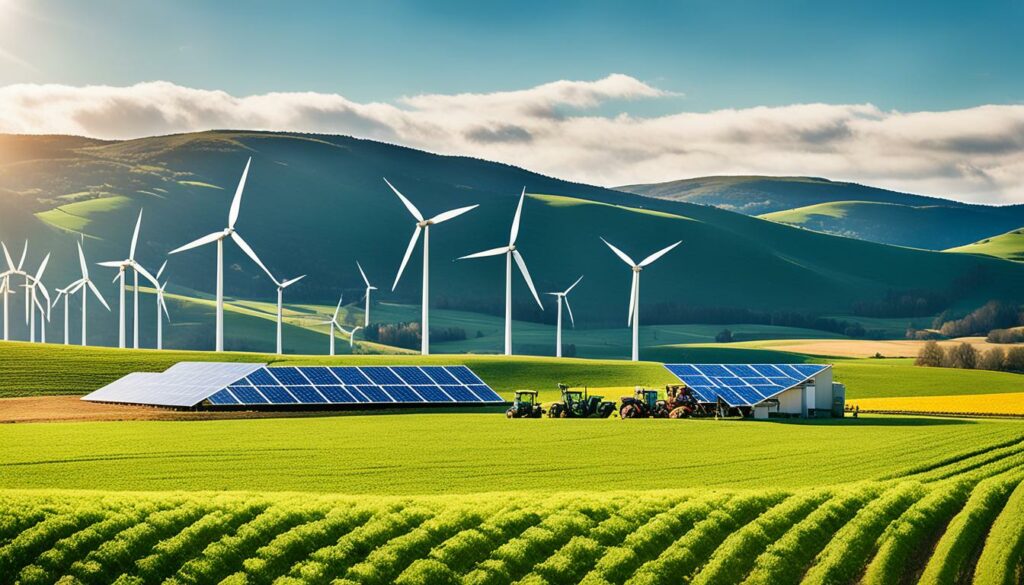
Solar power helps farmers save money by using sunlight. It lessens the need for other energy sources. This change supports the idea of farming in a way that keeps our planet healthy.
Farmers are also turning to the power of the wind, especially in windy places. They can sell extra electricity and earn money. For every wind turbine, they might make between $2,000 and $5,000 a year.
Biofuels, from plants like corn and soy, are a planet-friendly fuel. They cut back on our use of limited resources. This gives farmers a sustainable way to power their work.
Government schemes help farms get into renewable energy. The Inflation Reduction Act and programs like REAP cover half of the tech’s cost. They fuel up to 75% by combining grants and loans. The ITC chip in by cutting down solar system costs on taxes by 30%. This makes switching to renewable energy more affordable for all.
All these steps are part of a global push to fight climate change. Using eco-friendly farming tech not only makes farms more efficient. It also helps ensure the planet is healthy for the kids of tomorrow.
Farming faces high and changing energy prices now. So, turning to renewable energy is both vital and a chance. New agriculture technologies lead us to a greener, more economical, and less harmful future. By using solar, wind, and biofuel, farmers cut costs, gain energy independence, and make steady profits.
In Vermont, Roger Rainville makes biodiesel for less than $2 per gallon. He shows how renewable energy is a game-changer. Solar panels help cut down electricity costs and bring in extra cash. At the same time, on-farm wind turbines, says the U.S. Department of Energy, save money and make profits.
Choosing renewable energy means farming relies less on oil. It joins the world in fighting climate change. With green technology, farmers are less affected by energy price swings. They also lower harmful emissions and green farming. These steps are leading to a new era in farming. This modern, eco-friendly agriculture will thrive in the long run in the U.S. and beyond.
Farmers mostly use solar, wind, and biofuels for renewable energy needs. These types lower costs and tap into green alternatives. This shift benefits both the farms and the planet.
Solar power can make your farm more self-sufficient. It reduces electricity bills and could even earn you money. Plus, you can use it to power everything from water systems to buildings.
Wind turbines are a great way to make power. You can use this power yourself or sell it. They can also fit on unused parts of your land, keeping your farm running as usual.
Biofuels come from plants like corn and soy. They’re renewable and help farms cut down on using oil. These plants have many uses, helping farms be more efficient and save money.
You can find many types, including solar tractors and wind-powered water pumps. There’s also machinery that runs on biofuels. These machines reduce pollution and support the environment.
Using renewable energy can lower your farm’s long-term costs. You can even make money by selling extra power. By producing biofuels, farms can earn extra cash as well.
Yes, many groups offer help, from the government to state programs. Tax credits and rebates can reduce your costs. Don’t miss out on these chances to save money.
Farms have had great success with solar and wind. They extend growing seasons and save water. They also keep farms running well, showing the real benefits of green energy.
Getting started with renewable energy can be expensive. You might face tech issues and need skilled workers. But, there are ways to make it easier, from funding to ongoing support.
The future is bright with new solar and biofuel tech. The goal is to be more efficient and widely used. This points to a future where agriculture is kinder to the planet.
Going green in farming cuts down on bad emissions and saves land and water. It’s a big step forward in fighting climate change. This approach benefits both the environment and future generations.